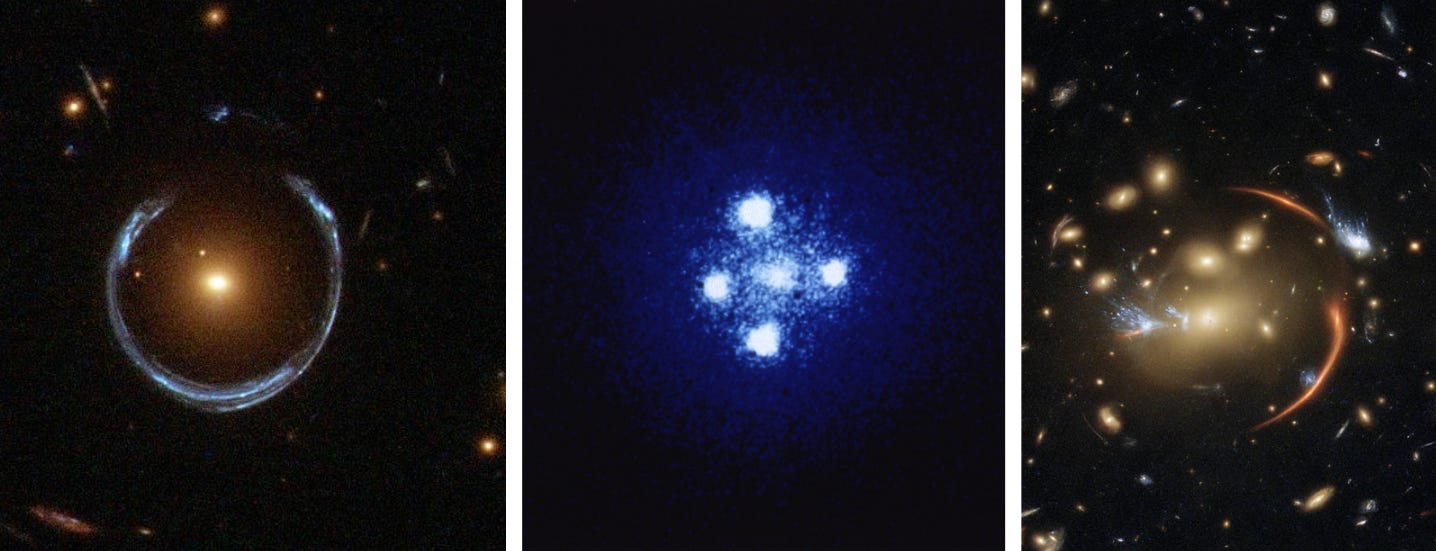KOSMOSEST #5: Gravitational Lensing or Mirage in the Universe
"Just as a wanderer in the desert can experience mirages, ... we may also see mirages in the Universe."
Welcome to the fifth issue of Kosmosest!
This newsletter varies between news round-ups, explainers of astrophysics phenomena, and shares what goes into studying our universe. Today’s issue gives an overview of gravitational lensing, an effect that allows astronomers reveal distant objects.
Take a look at the image below. In this mix of colourful objects, you’ll not only see the stars and the more recognizable shapes of galaxies, but also arcs of light. The Universe seems to be giving us a goofy smile.
What causes these distortions? Rays of light from a distant object can be bent by the gravity of another, very massive object (such as a galaxy or a galaxy cluster) as the latter warps the fabric of spacetime.
From our vantage point on Earth, the galaxy or galaxy cluster that lies between us and the background object acts as a powerful magnifying glass that distorts and amplifies the light from distant objects behind it.
Thanks to this phenomenon, objects from the early phases of the Universe can come into our view. Pretty amazing, right?


I enjoyed this poetic description from an ESA article on the physical effect:
"Just as a wanderer in the desert can experience mirages, when light from remote objects is bent by the warm air hovering just above the sand, we may also see mirages in the Universe."
Galaxy clusters are the most massive structures in the Universe, and the perfect example of a gravitational lens. The JWST Deep Field image of galaxy cluster SMACS 0723, released on July 12, 2022, shows intriguing examples of the lensing effect with the background galaxies seemingly stretching into bananas.
Gravitational lenses produce different shaped images as seen from Earth depending on the shape of the lensing body. In the case of spherical lenses, the image appears as a ring of light known as an Einstein ring (left one below). If the lens is elongated then the image appears as four objects in a cross, known as Einstein’s cross (middle one below). If the lens is a galaxy cluster, then the arcs of light you already familiarized with are formed.
Albert Einstein’s name stands out here: he wrote down a description of these effects as early as 1912—a prediction of his general theory of relativity1. Without his explanations, these cosmic smiley faces would be much more strange.

Thanks for reading!
If you enjoyed this week’s look into the universe, please consider spreading the word about it on social media.
Other ways to support educational content:
Leave a tip; you can think of it as buying the author a coffee: ko-fi.com/kosmosest
Like this post/drop a comment.
—MLA
If you’d like to go down the rabbit hole of the history of these theories, see:
Renn, Jürgen, and Tilman Sauer. "Eclipses of the Stars-Mandl, Einstein, and the Early History of Gravitational Lensing." (2000). https://pure.mpg.de/rest/items/item_2273846_1/component/file_2273844/content






